Anthony Bourdain and his younger brother Chris are on a mission to connect with their roots in Uruguay after learning that the Bourdains settled there many years ago.
Introduction:
Uruguay
Uruguay is a Spanish-speaking country located in the south eastern part of South America. Uruguay is one of the most economically developed countries in South America, with a high GDP per capita and the 52nd highest quality of life index in the world as of 2010, and first in quality of life/human development of Latin America, when inequality is factored in.
According to Transparency International, Uruguay is rated as the 2nd least corrupt country in Latin America (behind Chile).
Uruguary is home to some 3.5 million people. Metropolitan Montevideo is the only large city and has around 1.3 million inhabitants. The rest of the urban population lives in about 20 towns.
An estimated 88% of the population are of European descent, 10% have some degree of Black/African ancestry, 5.5% partial Indigenous, and 0.3% partial Asian ancestry. Most Uruguayans of European ancestry are descendants of 19th and 20th century immigrants from Spain and Italy (about one-quarter of the population is of Italian origin) and, to a much lesser degree, from France and Britain. Earlier settlers had migrated from Argentina and Paraguay.
Uruguay was the first South American country to legalize same-sex and different-sex civil unions at a national level, and to allow gay adoption. Uruguay was the only country in the Americas which did not go into recession as a result of the Late-2000s financial crisis. Uruguay is reimbursed by the UN for the majority of its military spending, because the majority of its military is deployed as UN Peacekeepers. In 2009, Uruguay became the first nation in the world to provide every child with a free laptop and wireless internet. Uruguay was the first nation in the Americas to test hemp cultivation, to legalize the growing of small amounts of cannabia for home consumption (as of April 26, 2011) and the possession or consumption in public.
Uruguayan culture is strongly European and its influences from southern Europe are particularly important. Unlike most Latin American countries influences from the indigenous cultures are minimal. The tradition of the gaucho has been an important element in the art and folklore of both Uruguay and Argentina. Beef is fundamental to Uruguayan cuisine and the country is one of the world’s top consumers of red meat per capita. Popular foods include beef platters, steak sandwiches (chivito), pastas, barbecued kidneys and sausages. Asado is a popular traditional dish in Uruguay, a kind of barbecued beef.
Montevideo
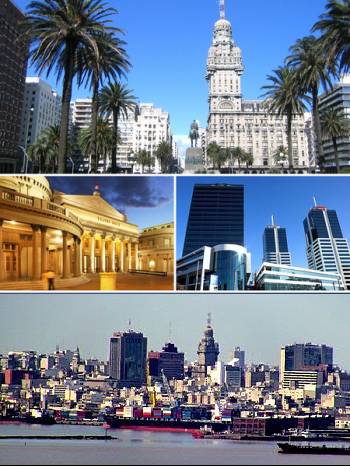 Montevideo, the largest city, the capital and the chief port of Uruguay, was first settled in 1726 as a strategic move amidst a Spanish-Portuguese dispute over the platine region, and as a counter to the Portuguese colony at Colonia del Sacramento. The city was under brief British rule in 1807 and was involved in the first major naval battle in the Second World War: the Battle of the River Plate.
Montevideo, the largest city, the capital and the chief port of Uruguay, was first settled in 1726 as a strategic move amidst a Spanish-Portuguese dispute over the platine region, and as a counter to the Portuguese colony at Colonia del Sacramento. The city was under brief British rule in 1807 and was involved in the first major naval battle in the Second World War: the Battle of the River Plate.
Today it is the largest city in Uruguay; an estimated 1.8 million live in Montevideo and its metropolitan area. Montevideo is the economic and political centre of the country. Banking has traditionally been one of the strongest service export sectors in Uruguay: the country was once dubbed "the Switzerland of America", mainly for its banking sector and stability. The Port of Montevideo, is one of the major ports of South America and plays a very important role in the city's economy.
Montevideo has a rich cultural heritage including tango and candombe. Described as a "vibrant, eclectic place with a rich cultural life", it is the hub of commerce and higher education in Uruguay. The architecture of Montevideo reflects its history, ranging from colonial to Art Deco, and influenced by Spanish, Portuguese, Italian, French and British immigrants. In 2007, Montevideo provided the highest quality of life in Latin America.
Tourism accounts for much of Uruguay's economy. Tourism in Montevideo is centered in the Ciudad Vieja area, which includes the city's oldest buildings, several museums, art galleries, and nightclubs, with Sarandí Street and the Mercado del Puerto being the most frequented venues of the old city. Most tourists to the city come from Argentina, Brazil, Chile and Europe, with the number of visitors from elsewhere in Latin America and from the United States growing every year.
Episode Recap:
Anthony Bourdain starts his sizzling tour of Uruguay in Montevideo with a brief history of his family.
National Archives in Montevideo: Upon landing in Urguary, Chris immediately heads to the National Archives in Montevideo to try to discover more information about their great-great grandfather Jean Bourdain, and potentialy any other remaining relatives. Chris learns that in the 1800's a huge influx of French immigrants came to the country, among them the Bourdains.
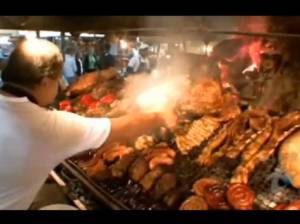 Mercado Del Puerto: Since Jean Bourdain would have gone to the open air meat market Mercado Del Puerto, Chris and Anthony visit the market as well. It turns out that the market is filled with food stalls that use parrillas, a style of grill used for cooking asado (barbecue) that are commonly found in South America, particularly Argentina, Chile, Uruguay and Paraguay.
Mercado Del Puerto: Since Jean Bourdain would have gone to the open air meat market Mercado Del Puerto, Chris and Anthony visit the market as well. It turns out that the market is filled with food stalls that use parrillas, a style of grill used for cooking asado (barbecue) that are commonly found in South America, particularly Argentina, Chile, Uruguay and Paraguay.
Estancia Del Puerto: Anthony and Chris choose to eat at Estancia Del Puerto. Anthony decides to sample it all: pork loin, chops, whole birds, steaks, flanks, filets, whole joints, kidney, sweetbread, and a mosaic of sausages all hissing and spitting, the smell wafting over everything in a glorious, joyous miasma of meatness. When facing a monumental amount of food, Anthony's strategy is simple. Sauce—chimichurri, parsley, garlic, olive oil, and spice. Vegetables—out of the question! Bread—useful only for the sopping up of sauce. Potatoes—wasted real estate unless doused with blood, grease, or other sauce that you can't resist taking a bite. After the brothers polish off a heaping pot of various cuts of grilled meat and tasty entrails, to the meatmaster's surprise they actually order yet another pot.
Anrich Family Ranch: The brothers head north to the farmlands of Lavalleja to the meet the Anrich family. They're ranchers, who with the help of their hired gauchos, raise and herd cattle. The family treat the brothers to an asado using a parilla. It starts with cheese, meat, peanuts and whiskey. A succulent piglet is cooked on the main parilla, with a slab of nandu (a large flightless bird similar to an ostrich) spiced up with chimichurri on the lower rack. The rest of the nandu is made into an estofado (a hearty stew), along with sweet potatoes, onions, tomatoes, garlic, and adobo spice. Also on the menu are some nandu eggs cooked in their shells and a prized local delicacy—"armadillo on the half-shell".
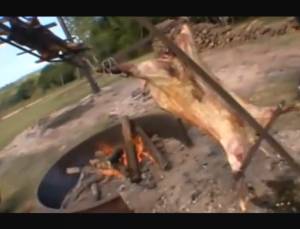 El Garzón: While Chris continues to research the Bourdain's genealogy, Anthony takes a side trip to the sleepy village of Garzón, about 20 miles inland from the coast, to meet chef and restaurateur Francis Mallmann. Chef Francis Mallmann left the fame and fortune of the city to return to a more rustic style of cooking in Garzón. Anthony is amazed at the traditional Amerindian and primitive outdoor cooking methods the chef utilizes. The food arrives on simple wooden boards: pork roast, pumpkin cooked in the ash; mixed vegetables roasted over piping-hot stones; torta frita (fried bread); torta pasqualina (fried cake); tender rib eye steak served with chimichurri sauce. Seasonings are minimal—citrus for acid, sea salt, pepper, and olive oil. Anthony is impressed with how brilliantly elemental, fundamental, and delicious it all is.
El Garzón: While Chris continues to research the Bourdain's genealogy, Anthony takes a side trip to the sleepy village of Garzón, about 20 miles inland from the coast, to meet chef and restaurateur Francis Mallmann. Chef Francis Mallmann left the fame and fortune of the city to return to a more rustic style of cooking in Garzón. Anthony is amazed at the traditional Amerindian and primitive outdoor cooking methods the chef utilizes. The food arrives on simple wooden boards: pork roast, pumpkin cooked in the ash; mixed vegetables roasted over piping-hot stones; torta frita (fried bread); torta pasqualina (fried cake); tender rib eye steak served with chimichurri sauce. Seasonings are minimal—citrus for acid, sea salt, pepper, and olive oil. Anthony is impressed with how brilliantly elemental, fundamental, and delicious it all is.
Punta del Este: Anthony and Chris take a little excursion to the luxurious Uruguayan beach resort of Punta del Este. Punta Del Este has scenic coasts and beaches, and is considered part of the South American Riviera popular among wealthy Argentinians. The city has much colonial architecture contrasting with more modern buildings. Gorlero Avenue, the main avenue of Punta del Este, has commercial galleries, restaurants, cinemas, casinos, and shops. Although the town has a year-round population of about 7,300, the summer tourist boom often boosts the population by an extra 500,000.
La Huella: Anthony spends the day relaxing at the beach, while Chris gets in some sight-seeing. Later they meetup for seafood at La Huella. Popular with the young and the fabulous, La Huella is a fashionable restaurant located on José Ignacio beach. Anthony finds the fired-roasted prawns and the sautéed octopus spectacular. They cap the dinner off with some caipirinhas.
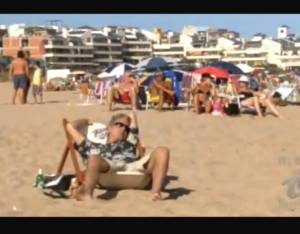
José Ignacio is a small village on the southern coast of Uruguay. Not long ago, this was a sleepy fishing outpost, a refuge for loners and the occasional celebrity seeking to escape the paparazzi in nearby Punta del Este, a glamorous playground often compared to St.-Tropez. But in the last five years, José Ignacio has evolved into arguably the chicest spot in Latin America, favored by jet-setters from around the world. Typical days include leisurely lunches at 3 p.m., late afternoons sunbathing at the beach, midnight dinners of braised lamb and sweet potatoes, and late-night parties given by luxury brands like Lacoste or Chivas Regal at beachfront tents. But that’s a small part of the allure. A big draw is the cuisine that offers not only the best seafood but invites to a variety of national and international dishes.
Cabo Polonio: Anthony and Chris travel to Cabo Polonio, located on a remote peninsula accessible only by specially designed and approved sand ferries.
Cabo Polonio is a modern day coastal hippy commune; an enclave of piratical misfits, a colony of outsiders, homesteaders, squatters, fishermen, and even some snowbirds. The region has no electricity or running water for the few hundred houses of this village. Wind power and a few generators are used to power some of the posadas (inns) and grocery store. Residents obtain water from nearby water wells or collecting rain water. This village's principal attraction is the Atlantic beach, a natural reserve of sea lions and one of the area's few mobile sand dunes, in which the sand is blown by the wind and the dunes actually change their position.
Beachside Lunch: The brothers have lunch with Raoul, a.k.a. "el Condor", who until recently was an expatriate, but is now a Canadian snowbird, returning each year to Cabo Polonio to avoid the frigid Canadian winters. Working in his makeshift kitchen, Raoul chops up some garlic, sautées it with some shrimp on his jerry-rigged propane stove, and serves it with some bread, cheese, salami and beer. The men romanticize about how enjoyable life can be when lived simply.
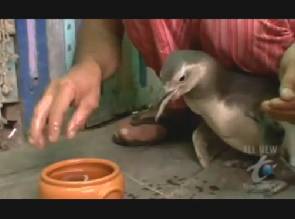 Le Bar De Joselo: Raoul takes Anthony and Chris down the beach to his favorite bar, Le Bar De Joselo. This "dive bar" is built out of driftwood, empty bottles and scrap, in dunes where there's barely a tree in sight, yet it's a virtual greenhouse. The bar's mascot, and Joselo's best friend, is a sickly-looking orphaned penguin named Pancho, who has a propensity to crap freely and constantly everywhere. The men enjoy some Licor de Butía, an alcoholic beverage made from the fermented berries of the Butia palm tree.
Le Bar De Joselo: Raoul takes Anthony and Chris down the beach to his favorite bar, Le Bar De Joselo. This "dive bar" is built out of driftwood, empty bottles and scrap, in dunes where there's barely a tree in sight, yet it's a virtual greenhouse. The bar's mascot, and Joselo's best friend, is a sickly-looking orphaned penguin named Pancho, who has a propensity to crap freely and constantly everywhere. The men enjoy some Licor de Butía, an alcoholic beverage made from the fermented berries of the Butia palm tree.
Candombe Block Party: Back in Montevideo, the journey to discover more about the Bourdains in Uruguay has lead to a deadend. However, Chris seems to take the disappointment well. He and Anthony "happen upon" a Candombe block party. This particular candombe group is known as Cuareim 1080, and it is directed by Waldemar Cachila, an recognized authority on candombe. As the group performs, Anthony and Chris eat grilled chirozo sausage sandwiches and drink siete y tres, a popular Uruguayan beverage made with 7 parts red wine and 3 parts Coca-Cola. Gradually the staged performance turns into a real block party as more and more residents from the neighborhood join in.
Candombe is a musical genre that has its roots in the African Bantu. Uruguayan Candombe is recognized by UNESCO as Intangible Cultural Heritage of Humanity. Originating from the influences of African music, it developed on both banks of the Rio de la Plata between Uruguay and Argentina because of the large influx of slaves during the colonial period and well into the nineteenth century. Over the 20th century, Uruguayan Candombe was gradually evolved from an unique feature of the Afro-Uruguayans to become a feature of the Uruguayan cultural identity.
Candombe is played mainly using three drums: the largest (lowest pitched) being "El Piano", the mid ranged tambor being "El Repique" and the highest toned tambor called "El Chico". Candombe is played using one drum stick and one open hand. The music of candombe is performed by a group of 50-100 drummers called a cuerda, commonly with rows of seven or five drummers, mixing the three types of drums. A full candombe group, collectively known as a candombera, is comprised of the cuerda, a group of female dancers known as mulattas, and several stock characters, each with their own specific dances that accent the arms and shoulders. One of the stock characters is the Escobillero ("Stick Holder"), who carries a long magical wooden stick that he uses to create new ways and possibilities for the future.
In the end, Anthony is resolute about not having discovered anything insightful about their family in Uruguay, his credo being it's more about the journey than the destination.
Episodes:
 |
ARGENTINA: From the Tango to paragliding to cattle rustling to trekking along icy glaciers, Anthony experiences it all. |
 |
AUSTRALIA: Melbourne has been described as San Francisco without the fog. Anthony is off to discover what makes it so special. |
 |
BERLIN: Anthony finds himself in Berlin, a city that is for him both good and evil, Eastern and Western, repulsive and appealing. |
 |
BRAZIL: Some say São Paulo feels like LA threw up on NYC. But Anthony's back for the great food and its welcoming people. |
 |
CALCUTTA & BOMBAY: Anthony revisits his love for India's vibrant culture, cuisine & communities with a trip to Kolkata & Mumbai. |
 |
COLOMBIA: A bright and beautiful country that has gone from drug capital to food capital. Anthony explores its unique cuisine. |
 |
EGYPT: Anthony skips the long lines and tour buses, and visits with Egyptian locals to get a taste for what it means to be Egyptian. |
 |
GHANA: Anthony heads to Ghana, West Africa, a land of old forts and slave castles, and a culture filled with great food and music. |
 |
GREEK ISLES: Anthony is on a culinary odyssey to discover if Greece really does have the world's healthiest diet. |
 |
HONG KONG: A wonder-land of colors, lights and speed, a perfect marriage of modern and traditional, and home to great Asian cuisine. |
 |
IRELAND: Ireland's steeped in history and traditions, both oral & written. Anthony dispels the myths that it has the worst food on the planet. |
 |
JAMAICA: Jamaica is a vibrant, colorful land full of resorts and reggae music. Anthony is there to uncover the lesser-known Jamaica. |
 |
KOREA: Anthony gives in to his employee's pressure to visit Korea and, next thing you know, they're in Seoul and the adventure begins. |
 |
MEXICO: Carlos, a head chef in NYC and good friend, gives Anthony a culinary tour of his hometown Puebla and nearby Mexico City. |
 |
OSAKA (Japan): Anthony learns all about kuidaore, which means to bankrupt oneself with extravagance in food and drink! |
 |
PARIS: In this very first episode of the series, Anthony heads to the "City of Light" to show, at least the Americans, why the French don't suck. |
 |
PERU: Anthony is on a mission to obtain personal enlightenment in a land of ancient culture, rich cuisine, and vibrant people. |
 |
QUEBEC (Canada): Anthony is off to Québec to indulge in one of his most hedonistic pleasures–foie gras (fatty duck liver). |
 |
RAJASTHAN (India): From gorgeous sights to enticing smells, Anthony explores the magical and delicious offerings of Rajasthan. |
 |
ROME: Anthony adopts the mindset of the Roman people–living a simple life and eating fresh, seasonal ingredients. |
 |
RUSSIA: Anthony explores Russia, where the food is hearty. Along the way he meets a former Cold War spy and Miss Russia. |
 |
SHANGHAI (China): Anthony is back in China. From Shanghai to Tibet, he searches for the mythical Shangri-La. |
 |
SICILY: Anthony starts his gastronomic tour through Sicily in style by sharing a spleen sandwich with Sicily's president. |
 |
SINGAPORE: Singapore is serious about food and offers up a cuisine like no other. Anthony dives in head-first. |
 |
SPAIN: According to Anthony, outside of Asia, Spain is the single greatest place for culinary achievement in the world. |
 |
TOKYO: Anthony is off to Tokyo in search of the relationship between a perfect piece of sushi and a perfect knife blade. |
 |
TUSCANY: Anthony travels to the beautiful Tuscan countryside to visit with friends and enjoy some homemade pasta that's out of this world. |
 |
VANCOUVER (Canada): Anthony visits Vancouver, home to a thriving film industry, gorgeous scenery, and an evolving food scene. |
Contact Us | Shop | Sitemap | Join Our Team | Investors | Advertise | Web Design Services
Community | Foodies' Choice | Meetup Groups | Chat | Blogs | Forums | Submit Your Site | Resources
